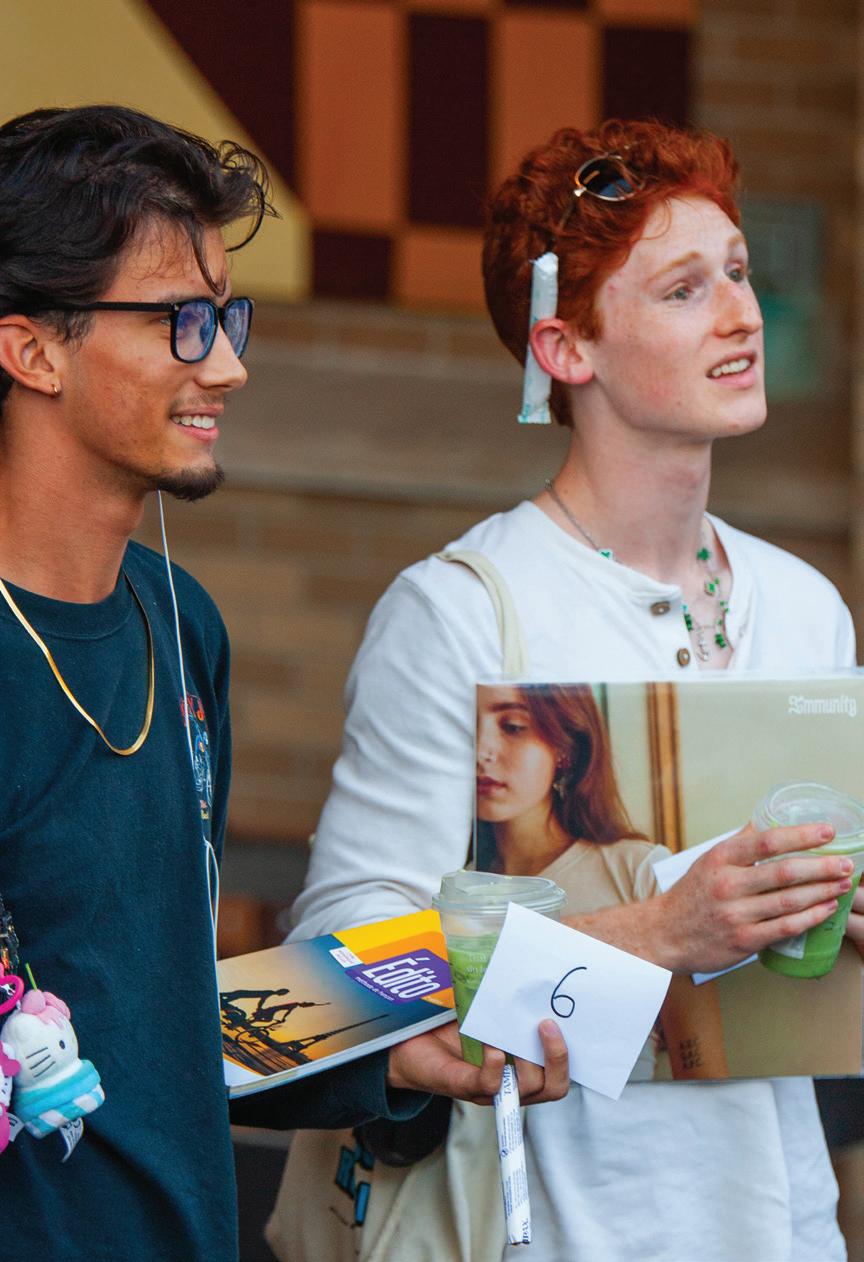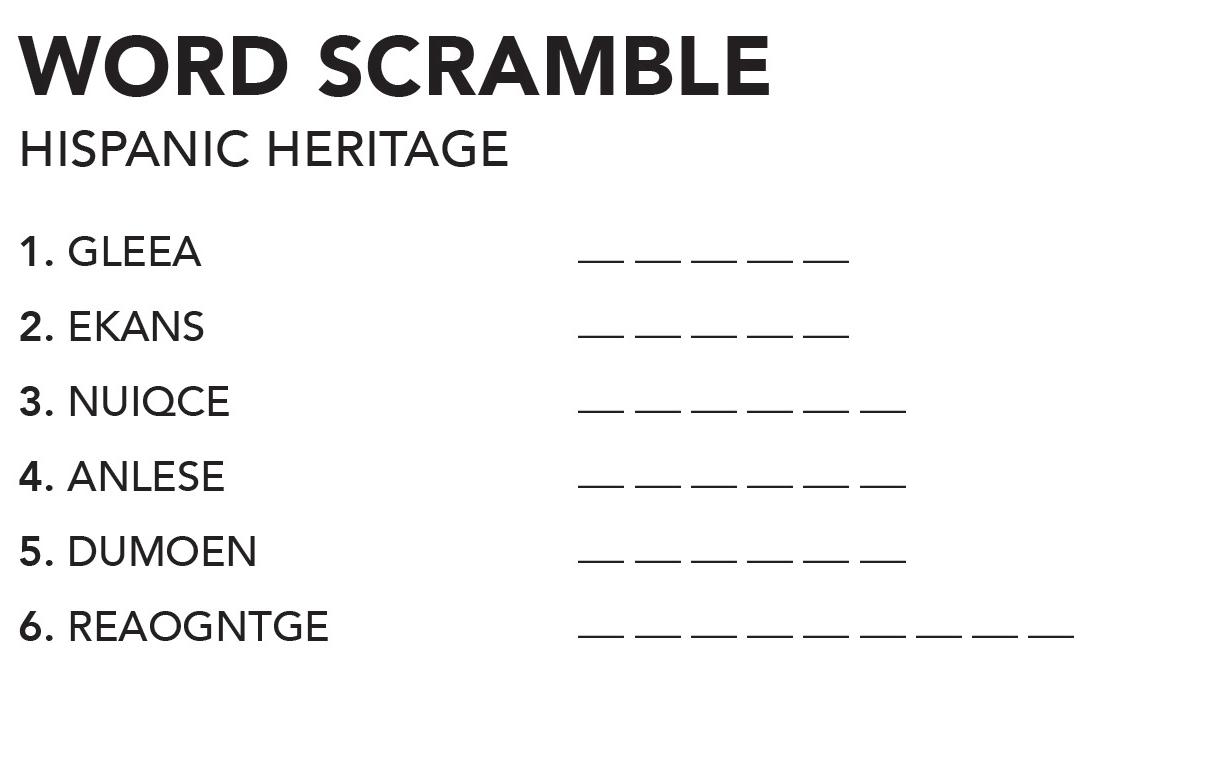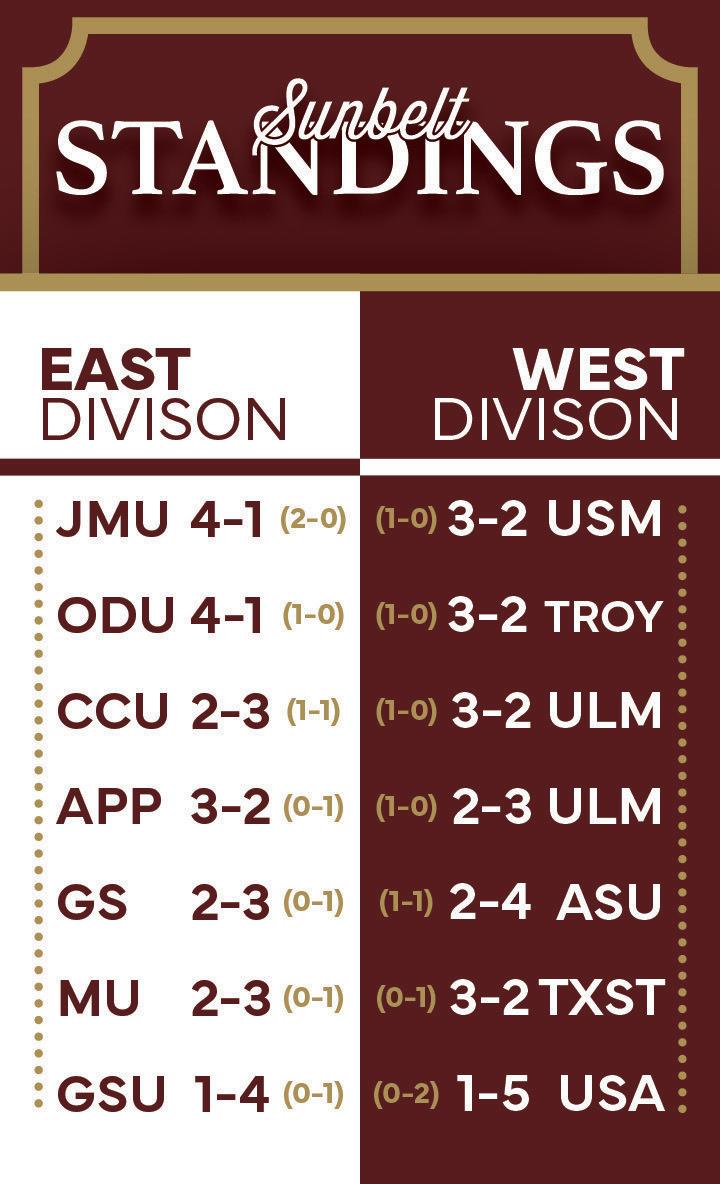




By Ayden Oredson Assistant Sports Editor
Lauded in the history of college football lie many traditions that fans cherish. Among those are the dramatic entrances of the teams. Virginia Tech has Enter Sandman, Colorado has Ralphie’s Run and now, Texas State has its own: the motorcycle moment. Before kickoff, after the Texas State Marching Band finishes the fight song and the Strutters and cheerleaders twirl and rally into position, the sounds of a revving Harley-Davidson Street 750 motorcycle echo throughout UFCU Stadium from the South Endzone Complex. Shortly after, it accelerates right onto the field, where the rider leads the charge for the football team to enter in theatrical fashion.
What makes the tradition unique is that the rider is always different: from Boko to alumni alike. Ultimately, the rider who tends to generate the most hype before the start of a game is University President Kelly Damphousse, creating a first home game tradition.
SEE TRADITION PAGE 9


By Arabella DiChristina Assistant News Editor
Texas State continues to meet R1 research institution requirements, with three new doctoral programs now accepting students.
The Carnegie Classification of Institutions of Higher Education defines R1 institutions as having high research activity, spending at least $50 million annually, and graduating 70 doctoral students a year for three consecutive years. Texas State is set to achieve this status by 2027.
Vice President for Research Shreekanth Mandayam said Texas State is expected to reach $180 million
‘There is currently no academic freedom in Texas’
Course audit sparks fears about academic integrity,
By Ryan Claycamp News Editor
The announcement of system wide course audits by the Texas State University System (TSUS) on Oct. 1 has sparked fear among faculty teaching about gender and LGBTQ+ studies.
The call for audits comes less than a week after Texas State University removed an LGBTQ+ communication studies class from the course registry and the Texas Tech System moved to limit discussion in its universities.
It also follows the firing of an A&M professor for discussing genderidentity in class, which led to the resignation of the president of A&M.
“As part of our commitment to academic excellence, and in light of recent inquiries about course offerings, we are asking each campus to conduct a collaborative review of its academic courses, programs, and syllabi,” John Hayek, TSUS Vice Chancellor for Academic and Health Affairs, wrote in an email to the chief academic officers of each TSUS university. “This effort will strengthen our academic mission and affirm the core academic values central to our institutions and system.”
According to Sandra Pantlik, vice president for marketing and communications at Texas State, the audit is currently ongoing.
By Carlene Ottah Life & Arts Editor
Among the warm sun and soft winds, Juan Leyva stood behind Spring Lake. A steady drumbeat played as Leyva blew into a conch shell, and an audience turned to honor each of the seven directions in Coahuiltecan: ota-ume, se’ta, we’fta, haya’mta, Uxuāl Xanāl, Tāp Tāi and naxasāl,
“We ask that you send prayers and good thoughts to the water, to the ancestors that are here, wherever you come from and who you represent and who you are connected with,” Leyva, an Indigenous Cultures Institute (ICI) volunteer, said.
The Sacred Springs Powwow, which
occurred on Oct. 4-5 this year, honored the Native ancestors who lived and died around the area, bringing together the art, tradition and languages of many Native cultures for an annual, two-day event. It began in 1995 when musician Lucky Tomblin first produced it in San Marcos.
This year marked the 15th anniversary since the ICI asked permission from Tomblin and his wife to reinstate the powwow as an annual event. Since then, it grew into a large event filled with traditional drumming and dancing, food and craft vendors, and educational programs.
SEE POWWOW
History Professor Jessica Pliley, who teaches about the history of women, genders and sexualities, said she heard about the audit from reading the news, not through the university.
“There’s been zero official communication from the provost’s office. I mean, there was one single email telling us that our course descriptions needed to match the content that we taught,” Pliley said. “But other than that, there has been no communication.”
While the TSUS letter doesn’t explicitly mention LGBTQ+ classes, or any other classes, as examples of what the audit is seeking to remove,

An Oklahoma Feather Dancer participates in the dancer grand entry in full regalia at the Sacred Springs Powwow, Sunday, Oct. 4, 2025, at The Meadows Center. The Oklahoma Feather Dance also known as the “Fancy Dance,” is a popular dance at powwows.

Tuesday, October 7, 2025
FROM FRONT LGBTQ+
the letter was provided to The Star in response to an inquiry about LGBTQ+ courses.
Distinguished Professor of History Emerita Victoria Bynum, who taught the first women’s history class at Texas State, said the letter failing to name specific programs, but instead applying to all courses, was concerning. She said it left the door open for broad changes across Texas State.
“It’s a sweeping review of all courses. That’s the point that I really want to make is that we have many innovative courses that have been inaugurated over the years and centers of study as well,” Bynum said. “I see it much more broadly than just gender studies. It’s an attack on education. It’s an attack on the university’s independence.”
According to TSUS Vice Chancellor for Marketing and Communications Mike Wintemute, changes made after the audit will not be uniform across all TSUS schools.
“It would depend on a variety of factors and might vary from institution to institution, if a course is not compliant with the law or hasn’t been approved through the established review processes,” Wintemute wrote in an email to The Star
Along with state pressure, the audit comes after President Donald Trump signed an executive order recognizing only two sexes in January. Trump also issued a national security memo on Sept. 25 calling “extremism on gender,” a term that is not defined in the memo, as a “common thread” in motivating political violence.
A tenured professor, who currently teaches a class related to gender and sexuality, spoke to The Star under the condition of anonymity, due to fears of retaliation. She said Trump’s executive order conflates the definition of gender and sex.
“Gender refers to the characteristics of women, men, girls and boys that are socially constructed,” the tenured professor wrote to The Star. “This includes norms, behaviors and roles associated with being a woman, man, girl or boy, as well as relationships with each other.”
According to the World Health Organization, sex refers to “biological characteristics that define humans as male or female.”
State Rep. Brian Harrison (R-Midlothian), who was also the main voice behind the firing of the professor at A&M, and later resignation of A&M President Gen. Mark Walsh, made an X post on Sept. 16, calling out Texas State for offering an LGBTQ+ communications class.
“I just found out that Texas State University is literally indoctrinating students in TRANSGENDER
‘RESISTANCE’ and TRANSGENDER
‘JUSTICE!’” Harrison wrote on X.
Harrison introduced House Bill 2339 in the 89th Legislative Session to prevent universities and colleges from offering courses in “LGBTQ or DEI studies.” However, it failed to pass, meaning that despite significant pressure from elected officials to remove the classes, there is no law banning LGBTQ+ studies at institutions of higher education in Texas.
Despite that, Pliley believes government and university officials are using House Bill 229, a 2025 Texas law that only recognizes two biological sexes, as an excuse to ban the classes.

Trinity Building 203 Pleasant St. San Marcos, TX 78666 (512) 245 - 3487
History: The University Star is the student newspaper of Texas State University and is published every Tuesday of the spring and fall and once a month in the summer semesters. It is distributed on campus and throughout San Marcos at 8 a.m. on publication days with a distribution of 3,000. Printing is by the New Braunfels Herald-Zeitung.
Read more at universitystar.com
Pliley said that is in direct contradiction to Senate Bill 17, passed in 2023, which explicitly stated class curriculum would not be impacted by DEI bans.
The tenured professor went further than Pliley, instead saying the removal of courses and other recent actions by the university are illegal.
“I cannot believe that this has progressed so far, on such completely flimsy grounds,” the tenured professor said. “To me, it speaks directly to the inability of our administration, not only at the presidential and administrative level of Texas State University, but also down to the colleges themselves; it speaks to just a failure to lead.”
According to Pliley, the pressure from officials, as well as the recent termination of Associate History Professor Thomas Alter, has led to other faculty members self-censoring and deciding not to offer classes that deal with gender and sexuality.
“Everybody is so scared after [the] firing of Tom Alter, that there has been an extraordinary dampening down of free speech on campus,” Pliley said. “People are self-censoring to such an extent that they are choosing not to offer these classes. They’re choosing just not to schedule them for the spring or for the fall of next year, which has a direct impact on students.”
Pliley expressed concerns that some students, such as those minoring in women’s, gender and sexuality studies, could experience delayed graduation dates due to classes not being offered.
According to Pliley, there have also been at least three instances of courses being removed from the course directory by the university administration and not the professor offering the course. She said that none of those courses had any students currently enrolled in them.
Sandra Pantlik, vice president for marketing and communications, refuted that claim, stating the university only removed one class, COMM 3316I: LGBTQ+ Communication Studies, after Harrison’s post. The class was not being offered this semester.
After the class removal, Congressman. Chip Roy (R-Austin) said the university should remove other classes, too. He issued a statement and wrote a letter to Texas State President Kelly Damphousse calling for the removal of a separate LGBTQ+ communications class for graduate students.
“When a public university elevates LGBTQ+ ‘resistance’ and creation of ‘justice’ as learning outcomes rather than subjects for critical debate, it abandons education and embraces indoctrination,” Roy wrote in his letter. “This is not neutral academic inquiry; it is taxpayer-funded activism.”
Audrey Oliver, communication studies alumna, previously took COMM 3316I: LGBTQ+ Communication Studies. Oliver disputed claims that LGBTQ+ studies were indoctrinating students.
“The professor never once told us to do anything in particular, vote a certain way, think a certain way,” Oliver said. “She was just laying out facts. And we were allowed to feel how we felt about it, and we were encouraged to do our own research.”
All three professors also disagreed with the claims about indoctrination.
“I find that word ‘indoctrinating’ interesting because it appears to me that when we educate students on
Editorial Staff
Editor-in-Chief: Blake Leschber stareditor@txstate.edu
Managing Editor: Rhian Davis starmanagingeditor@txstate.edu
News Editor: Ryan Claycamp starnews@txstate.edu
Life & Arts Editor: Carlene Ottah starlifeandarts@txstate.edu
Opinions Editor: Andrew Bencivengo staropinion@txstate.edu

things that, maybe people at other levels or other positions don’t want them to learn, suddenly it’s not education, it’s indoctrination,” Bynum said. “I would like them to explain to me what the difference is between education and indoctrination.”
The professors also characterized the audit and course removals as attacks on the academic freedom and independence of faculty.
“There is currently no academic freedom in Texas,” the tenured professor said. “Freedom doesn’t go away when it’s banned. Freedom goes away when people change anything about their actions and words and activities out of fear. So as far as I’m concerned, it’s gone.”
The three professors expressed concern that actions such as the removal of classes about LGBTQ+ individuals, and possibly other groups in the future, would send a negative message to minority students on campus.
“[State officials] do not serve them at all with this new sort of curriculum that they are envisioning, and it’s a betrayal of the university’s mandate and it’s an insult to the students themselves,” Bynum said.
Pliley worries the curriculum change could lead to some students feeling unsafe at Texas State and others choosing to enroll at different universities.
“If [students] identify within that larger queer umbrella, they say that Texas State had a reputation for being a safe space, and that’s why they wanted to come, or why they did come,” Pliley said.
Oliver said she was not surprised
Sports Editor: Adrian Ramirez starsports@txstate.edu
Multimedia Editor: Meg Boles starmultimedia@txstate.edu
Engagement Editor: Tatum Pou starengagement@txstate.edu
PIR Director: Keely Florez starpr@txstate.edu
Creative Service Director: Carson Rodgers starcreative@txstate.edu

Design Editor: Jen Nguyen stardesign@txstate.edu
Director: Laura Krantz, laurakrantz@txstate.edu
ROWAN CLARK | STAR
that the university would no longer offer the class, but that she disagreed with its removal.
“It’s bizarre, because it’s not even a required class,” Oliver said. “It’s a communications class, but it’s not part of the core curriculum. So no one’s forced to take it.”
Bynum said she can’t recommend that every faculty member speak out against the crackdown on courses and faculty speech because she doesn’t know everyone’s situation, but she hopes more professors will speak out.
“I do understand the fear and so I want to express sympathy for those people and for what they fear, but at the same time express my sorrow, that more people don’t feel that they can speak up because I do think we need everyone who can to speak up, and that’s why I am,” Bynum said. “In fact, I’m afraid that if we don’t all participate at whatever level we feel we can safely do, we’re gonna lose this battle.”
The tenured professor expressed concern that more current students aren’t willing to speak up about this issue.
“What remains true is that students, they have a voice, and they have enormous power in banding together and letting the administration know that they’re really unhappy with what’s going on,” the professor said. “We’ve seen students get programs created because they banded together and asked for them, and really protested in favor of them. This is the time now for it to happen again.”
This is a developing story. The University Star will update as information becomes available.
Publication Info
Copyright: Copyright Tuesday, October 7, 2025. All copy, photographs and graphics appearing in The University Star are the exclusive property of The University Star and may not be reproduced without the expressed written consent of the editor-in-chief.
Corrections Policy: Errors appearing in the pages of The University Star and brought to our attention will be corrected as soon as possible.
Advertising Inquiries Contact at: 512-245-3487 advertising@universitystar.com
By Ryan Claycamp News Reporter
The Department of Education announced on Sept. 10 that it will end grant programs to MinorityServing Institutions, such as Hispanic Serving Institutions like Texas State.
Ending grant programs has resulted in the loss of $2.1 million in research funding to Texas State, with millions more in funding at risk, according to Vice President for Research, Shreekanth Mandayam.
“We had 26 awards totaling $11 million. Out of that, only one award has been canceled, and we have lost $2.1 million,” Mandayam said. “So in context, it’s out of a portfolio of $250 million and $180 million [in] annual [research] expenditures.”
According to the Hispanic Association of Colleges and Universities, HSIs are defined as not-for-profit colleges and universities in which at least 25% of full-time equivalent undergraduate students are Hispanic. The Department of Education has removed its webpage defining HSIs.
According to the Department of Education’s press release, the decision comes after the Solicitor General determined the grants violated the 5th Amendment in July. The press release further states that the Trump Administration considers the programs racially discriminatory.
“To further our commitment to ending discrimination in all forms across federally supported programs, the Department will no longer award Minority-Serving Institution grants that discriminate by restricting eligibility to institutions that meet government-mandated racial quotas,” U.S. Secretary of Education Linda McMahon wrote in the press release.
The press release stated the $350 million, of federal dollars, that was planned to fund minority grant programs will instead go to other programs that “advance administration priorities.” According to Texas State’s website, the university has received 44 grants and financial awards totaling over $58.7 million since becoming an HSI.
“The HSI designation enables us to compete for federal funding that increases our capacity to strengthen programs, enhance research infrastructure and capacity, and support our students,” the university wrote on its website.
Mandayam said the one grant that has been canceled at this time funded “Proyecto Excelencia.”
in research expenditures and 80 doctoral graduates in the fiscal year 2025. Texas State is set to achieve R1 status by 2027.
“We have double the number of Ph.D. programs,” Mandayam said. “We invested an additional $50 million in additional Ph.D. programs in science and engineering, mainly, which is where graduation rates are typically higher than other disciplines.”
Three doctoral programs in electrical engineering, mathematics and mechanical and manufacturing engineering began enrolling its first students in fall 2025.
According to Mandayam, there are “Run to R1” doctoral scholarships and Doctoral Research Assistantships (DRA) tuition waivers to keep students on track to graduation.

Proyecto Excelencia was a program seeking to improve student retention and graduation rates, and increase transfers from HSI colleges to Texas State, among other goals.
While the university has only lost a single grant at this time, Mandayam said there are eight more grants he is concerned may be canceled.
“We’ve been looking at these grants to see if there’s a risk of any of them being terminated, and it’s possible. Out of the [25], eight of them have what is called a federal assistance listing that required minority beneficiaries,” Mandayam said. “I don’t want to cause alarm to faculty and students, but it is possible that some of those eight out of those 25 left may be at risk.”
Mandayam created a new program, called Pivot, to address changes in grant requirements. He said the program uses money from the Texas University Fund endowment to temporarily fund projects while they seek new long-term funding. The endowment
gives Texas State an additional $60-70 million a year in research funding.
“Again, it has to satisfy Texas law and new federal law so we can pivot some of these programs,” Mandayam said. “So that is what we are trying to do to help, to minimize impact, but definitely the institution cannot permanently support federally awarded research grants.”
Changes in federal funding priority aren’t a new thing, Mandayam said. What he said is new is the scale and pace of changes in priority.
“Keeping up is hard, but we’re doing it and Texas State is doing very well,” Mandayam said. “Our research went from $70 million before [President Kelly Damphousse] and I came here, now we are at $180 million in annual research.”
This is a developing story. The University Star will update as information becomes available.

“For those students in assistantship, I’m giving them an additional tuition scholarship so that they don’t have to pay tuition from their stipend that they’re already getting, which is what they used to do earlier,” Mandayam said.
Dean of the Graduate College Andrea Golato said doctoral students can receive a tuition waiver only if they hold a research assistantship and their graduate advisor has funding from an external grant.
According to the Associate Vice Provost for Curriculum and Academic Programs Jeff Housman, for the first five years after a doctoral program is approved, the curriculum office has to conduct annual reports to the Texas Higher Education Coordinating Board (THECB). The reports focus on anticipated enrollment, services provided and student support.
“In general, I think we’d like to see an average of three years for completion,” Housman said. “We’d like to see students complete those degrees and have a really good return on investment.”
Golato said the average time for a student to complete a doctoral program is three to five years at Texas State; however, it varies due to the doctoral program and background education.
However, according to Coursera, doctoral students take an average of seven years to complete their degree after beginning graduate school, and about five years after starting their doctoral program.
“While many Ph.D. programs are designed to be finished in four or five years, the average completion time is much longer when you factor in the time it takes to research and write a dissertation,” Coursera’s staff wrote in its article.
Golato said doctoral students completing their program in three years “would be a very rigorous timeline.”
Golato continued, stating doctoral students can finish their degree in three years if the student already holds a master’s degree and was a full-time student.
“If you were entering [Ph.D. programs] with a master’s degree, they have between 54 and 60 credit hours
that the student needs to complete, if you are entering with a bachelor’s degree, there is additional coursework of usually a year and a half to go,” Golato said.
According to Texas State Financial Aid and Scholarships, doctoral students need to be full-time students, which is nine credit hours, that count toward their degree, in order to receive the most financial aid and the tuition waiver.
“I just started [my Ph.D. program] last fall. It’s been going, I shouldn’t say great, because it’s completely a new experience,” Doctoral Instructional Assistant, Md Khairul Azman said. “... so all the research courseworks and as well as the DA duties, it’s been piling up the last two months ... it’s been difficult.”
Azman said he is a first-year Ph.D. computer science student and hopes to finish in four and a half years.
Houseman said before any doctoral program is proposed, the provost’s office conducts a job market analysis to determine the demand and salary outlook for those credentials.
Texas State University has access to the Texas University Fund (TUF),
which Mandayam said allows for $60-$70 million a year to be invested in research.
Mandayam said Texas State is investing TUF in two ways: people and places.
“Which means we want to recruit the best faculty in the country in the world to come to Texas State. We want to recruit the best students in our graduate and undergraduate programs out here,” Mandayam said. “So it really is investing in the people who do the research. Secondly, the infrastructure for the research, the labs, the equipment, the facilities, and the support personnel.”
Mandayam said the four main investment areas include: water resources, semiconductor chips, artificial intelligence and dementia and Alzheimer’s research.
“We are shortly starting a series of town halls that invite faculty and students from across the university, where we can discuss how we are going to grow and excel in these areas,” Mandayam said.
In the fiscal year 2024, Texas State reached the R1 criteria with $165 million in research expenditure and 71 doctoral graduates, however it must maintain requirements until 2027 to receive the R1 designation.
There are 16 universities in Texas that have reached R1 status, according to the THECB.
Texas State University’s Strategic Plan for Research states Texas State plans on submitting proposals for new doctoral programs on a yearly basis to the THECB.
Scan the QR code to see The University Star’s previous coverage on R1 status.

October 7, 2025
Opinions in The University Star are not necessarily those of our entire publication, Texas State University’s administration, Board of Regents, School of Journalism and Mass Communication or Student Publications Board.
By Jolee Gavito Opinions Columnist

Texas State removed an LGBTQ+ communications course from its course catalog. Eliminating this course sets a precedent of dissolving additional courses in the near future, and limits safeguards for LGBTQ+ students and student organizations.
The course, COMM 3361I: LGBTQ+ Communication Studies, helped students understand the historical and recent hardships of the LGBTQ+ community. The elimination of the course is a result of pressure from online voices and government officials.
Instead of aiding universities across Texas, officials seem to want to target courses that cater to students pursuing LGBTQ+ and gender studies degrees, with no care towards student choice nor academic stewardship.
State officials don’t have the same privilege as higher-learning institutions, meaning only these institutions have the power to review what courses will be offered. The Texas legislature is aiming to strike down LGBTQ-centered courses by needlessly accusing universities of instilling compelling information in their students.
U.S. Rep. Chip Roy (R-Texas) wrote a letter addressed to

Damphousse, regarding Texas State’s inclusion of LGBTQ+ related curriculum, asking if the university was subsidizing activism.
“When a public university elevates LGBTQ+ “resistance ... it abandons education and embraces indoctrination,” said Roy. “The university continues to offer COMM 5329J — LGBTQ+ Communication.”
As of Oct. 5, COMM 5329J has been erased from TXST’s course catalog. The immediate removal of COMM 3361I and COMM 5329J occurred merely days after the letter was sent.
Roy represents the 21st district, which encompasses small parts of
northern San Marcos. However, he holds zero jurisdiction over the Texas State area. Roy’s letter can be best described as an extreme abuse of power.
Once education becomes politicized, it sends an unwelcome message from universities to individuals of marginalized communities. In effect, there will be distrust and further tension among communities at Texas State.
“Removing these courses [means] that the LGBTQ+ community has less power to define themselves.” Sophia Farnsworth, advertising junior, said. “The priority of Texas State should be protecting all of their students.”
Another active threat to LGBTQ+ courses consists of course auditing, ordered by the Texas State University System (TSUS). The guidelines within the TSUS policies, as well as the educational needs for students, remain unclear and are at risk of unfair biases.
Students have the right to choose their own classes, as well as where they would like to continue their educational journey. Eliminating classes related to the LGBTQ+ community sets a clear and present danger to the existence of all LGBTQ+ students at Texas State. The more course content that’s censored, the more unaware and uneducated Texas State students will be.
Rather than protecting vulnerable marginalized communities, state officials continue to restrict safe outlets for educational learning. The TSUS must base its course assessments on true integrity, not on written words from a politician, to further ensure the educational rights of all students.
Calling for the removal of any course on the grounds of an opinion instead of academic importance lays the groundwork for more courses to be erased. A precedent of erasing courses relating to marginalized groups will plague education opportunities for present and future students.
-Jolee Gavito is a journalism junior
By Levee Abbott Opinions Columnist

Attacks on minorities at
Texas State are dangerous to the future of a diverse campus. Whether you agree with the labels others assign to themselves or not, they will always be there. As language evolves, there will always be new categories for people to put themselves into.
Texas State isn’t protecting the student body from radical ideologies; it’s pushing them into boxes and isolating the communities that make up the university.
Labels are words assigned to categories of identity. Labels make up ones identity, and show parts of themselves that aren’t always evident.
According to an article by Elisabeth Camp and Caroliba Flores in The Philosophical Quarterly, there is a consensus that Gen Z lets their labels consume them, but labels have been around for ages and are important to cultivating cultural communities.
Gen Z’s infatuation with labels is nothing new; it’s just a symptom of our ever-evolving culture. Understanding the nature of the labels we subscribe to can and have fostered communities for all of human existence. Still, our hatred consumes us so deeply that we are alienating each other, cultivating a society built on bullying.
At Texas State, students, faculty and staff express themselves in many different ways, yet this difference in expression helps the campus become a more diverse place where new ideas and people can mix. Now,
this expression, especially at Texas universities, is being placed under scrutiny by government figures and outside actors.
The state and federal government have taken to targeting people based solely on their identity. In Texas, legislation, like Senate Bill 8, a bill passed to regulate the sex of those who use public bathrooms, targets individuals based on how they identify.

The government is suppressing real identities and Texas State is doing nothing to stop it. The suppression of LGBTQ+ history opens the floodgates to further discrimination against minority groups. Already, the U.S. Department of Education has added budget cuts to all minority-serving institutions, including Texas State.
These budget cuts come under the guise of protecting students from racial discrimination, and comes after the Supreme Court paved the way for identity, or race, to be cause for immigration raids. Although, according to the American Council on Education, Hispanic students are the second lowest population to attend college, the cuts only serve as a punishment to them.
Administrators cannot keep succumbing to government bullies; it
The University Star welcomes letters from our readers. Letters must be
300 words or fewer to be considered for publication. Writers must include their full name, mailing address, major and academic year designation (for students), phone number and e-mail address when submitting a letter.
Submissions that do not include this information cannot be published. This information is seen only by the editors and is used to verify the identify of the
evokes a McCarthy-style fear among not only professors but also the student body. Communities that are vital to our campus are being squandered, and people are forced to repress their identities.
Christopher Hernandez, a theater sophomore who identifies as gay, said the administrations actions are telling of the focus for the student body.
“I feel it’s very disheartening, because a large population at Texas State, they do align with the LGBTQIA+ communities, and seeing as though he kind of folded so quickly to the outcry of the Texas Legislature, shows that he is not so much willing to fight for us, but to do whatever it takes to keep the school’s funding,” Hernandez said. Regardless of the government’s disagreement, the suppression of certain identities only construes history
in a dangerously propagandistic way.
“No matter what way you look at politics, there is going to be LGBTQIA+ people at the forefront,” Hernandez said. “Whether you try to look at it from a religious standpoint, [or] a biological standpoint, it is undeniable that LGBTQIA+ people have had a massive impact on people.”
How someone identifies is innately personal to them, and the government should not be in the business of telling people how to do so, nor should they use their power to suppress these voices. Labeling oneself is a normal part of identity, and students should not be afraid to represent themselves how they choose.
-Levee Abbott is a English sophomore
letter writer. It is not used for any commercial purpose.
Letters become the property of The Star and may be republished in any format. The letter may be edited for length and clarity. An editor will contact the letter writer if their letter is a candidate for publication. The Star will not run letters that are potentially libelous, discriminatory, obscene, threatening or promotional in nature.
Letters can be submitted to staropinion@txstate.edu or by mail to Attn: Opinion Editor, The University Star, 601 University Drive, San Marcos, TX, 78666.
Oklahoman Feather Dancers participate in the dancer grand entry at the Sacred Springs Powwow, Saturday, Oct. 4, 2025, at The Meadows Center. The Oklahoma Feather Dance, also known as the “Fancy Dance,” is a popular dance at powwows.

MEG BOLES | MULTIMEDIA EDITOR
Geography natural resources
freshman
Pablo Correia (left) and biochemistry
freshman Mac Willis (right) compete at the Texas State Performative Male Contest, Saturday, Oct. 4, 2025, at the LBJ Amphitheater. Correia would win the competition, and the grand prize of a Labubu.

AIDEN FRITSCHE | STAR PHOTOGRAPHER


Scan the QR code to view all photos.








On rows, read left to right. There must be at least one block of space between each number.
On columns, read top to bottom.





and
for the
Monday, Oct. 6,
By Vanessa Rivera Life and Arts Contributor
For the Texas State Homecoming service project, Student Involvement and Engagement is organizing a donation drive to help San Marcos residents served by Southside Community Center, a local non-profit organization that helps individuals and families meet essential needs.
The donation drive is part of World Homeless Day, an international day observed annually on Oct. 10, with the primary goal of encouraging communities to get involved in raising awareness on people experiencing homelessness.
Jason Garcia, coordinator for Community Service and Volunteer Programs, said the inspiration for this year’s Homecoming service project came from Texas State’s partnership with Southside Community Center and Student Involvement.
“[What] we noticed was [that] Southside Community Center has always been a constant and great partner for us throughout my time here at Texas State,” Garcia said. “We thought it was the perfect opportunity and timing to go ahead and have this partnership happen, and that led to our donation drive with Southside.”
Southside has been a volunteer site for student
organizations or individuals looking for hours. Last fall, Student Involvement launched Service Saturdays, a list of several projects available per semester where students can give back to the community.
Leadership and Service wanted this year’s drive to be dedicated to uplifting the local community and raising awareness about homelessness through continuous community efforts.
“[The drive] is a perfect opportunity to raise that awareness, not only for students but also in the larger community in general,” Garcia said. “I don’t want this [drive] to be a one-time thing, and then we forget Southside exists hereon after. I want students to invest their time at Southside and the larger community in general.”
Students are encouraged to donate new or gently used items such as coats and jackets, toiletries and backpacks. Donation drop-offs started on Oct. 6 and will end at 5 p.m. on Oct. 11 in the Shirley R. Harris Student Lounge in Suite 204 of the LBJ Student Center. Students can also financially support Southside Community Center by donating money directly to its initiatives.
Jessica Cain, director of neighborhood engagement at Southside, has worked closely with Garcia and Student Involvement, specifically during Home-

‘Rally
coming week for this year’s service project.
“Back in August or early September, we started talking about what [the donation drive] might look like and what we would need,” Cain said. “It so happens that Homecoming this year lines up with World Homeless Day, which is on Oct. 10, so we focus the drive on the things we’re going to need for World Homeless Day that are also helpful items to have going forward throughout the year.”
In addition to this drive, Southside remains committed to addressing the issues and raising awareness about homelessness in general.
“We are, at Southside, the main organization in San Marcos, and even in the wider Hays County, working on certain pieces of addressing homelessness,” Cain said. “We just need some more support, and this [drive] is a great support for us.”
Cain said small acts like volunteering and supporting neighbors in the community have a big impact in their lives.
“Sometimes, it’s easy to not know the impact you have, but Texas State has a huge impact on the community and a really positive impact for our neighbors here at Southside,” Cain said.
By Carlene Ottah Life and Arts Editor
From yard games outside to video games inside a gaming trailer, music and cheers will erupt from the University Events Center (UEC) Lawn on a Thursday evening for a new pregame social.
“Rally at the Net” is a Homecoming event aiming to bring awareness to Texas State’s volleyball game on Oct. 9. It will be from 4-5:30 p.m., leading up to the volleyball team taking on South Alabama at 6 p.m. Activities will include spike ball, giveaways and other spirit-building activities.
“Our head coach Sean Hewitt will come out before the game to chat with people who have come to attend, and we’ll hopefully have some beverages and snacks for those students as well,” Tori Thompson, assistant athletic director of marketing and fan development, said.
Texas State Athletics and Student Involvement and Engagement came up with the idea to create a tailgate event outside of the UEC.
“We’ve been planning for Homecoming since last April, and this summer, when we met with athletics during our planning process, we realized that there was a volleyball game and so we just worked that into our Homecoming schedule,” Duane Bruce, executive director of Student Involvement and Engagement, said.
Volleyball normally plays on Friday and Saturday nights but had to move up its game to avoid interfering with Saturday’s football game versus Troy. As a result, both departments wanted to ensure they pushed as much attendance and energy to Thursday’s game as possible.
“Since it’s right in the middle of Homecoming Week and there’s a lot of events going on, we thought, ‘Why not get people to come to that as well?’” Thompson said.
According to Texas State’s 2024 volleyball’s record book, the previous volleyball season had a total of 11,284 people attend 13 home games, aver-
aging at 868 attendees per game.
When working on these types of events, Thompson said Texas State Athletics and Student Involvement and Engagement discuss what would be entertaining for students, what makes sense for the space, and what will keep them there and into attending the volleyball game.
This led to the chosen location and tying in different departments to supply the activities. For instance, Campus Recreation will provide equipment such as spike ball and will let “Rally at the Net” borrow a few of its games.
As Thompson said, this is the first time both departments will have an event like this and the event has no sponsors, they used what they could to keep costs to a minimum. This included what equipment and activities were available to use and what worked at other events.
“We’ve got lots of ideas on how we can engage students, and not just football but all of the athletic events that are happening across or at Texas State this year,” Bruce said.
Bruce and Thompson remain hopeful about “Rally at the Net” and its turnout. They wanted to bring awareness to volleyball and add this event to that atmosphere, hoping students will come out and enjoy it.
“Since [students] will already be in the vicinity of the game and that’s what we’ll be encouraging them to do, we’re hopeful that a good portion of those students will come on in and enjoy it, at least for a little bit,” Thompson said.

Scan the QR code to learn more about “Rally at the Net.”
Tuesday, October 7, 2025
FROM FRONT POWWOW
This year marked the 15th anniversary since the ICI asked permission from Tomblin and his wife to reinstate the powwow as an annual event. Since then, it grew into a large event filled with traditional drumming and dancing, food and craft vendors, and educational programs.
Each powwow begins with a blessing at the shores of the Sacred Springs at Spring Lake. Whenever the ICI holds an event, it asks permission of the elements to be there and for blessings and guidance for what it is doing.
The seven directions are east, south, west, north, Father Sky, Mother Earth and “my heart.” Leyva said east and west represent the sun rising and setting, but north and south differ depending on the culture. Father Sky is often associated with the heavens, and they give thanks to Mother Earth for what she provides.
“There’s this story that the creator of the cosmos created all things and at the very end said, ‘I have the spirit of the people, but I don’t know where to put it,’” Leyva said. “Then the idea came where the creator said, ‘I know where I’ll put it. I’ll put it inside of the people because that’s the last place that they’ll look.’”
Sylvia Jean, retired administrative associate at UT Austin, has participated in many communities and powwows for over 35 years and danced in competitions. She offered a blessing during the ceremony to for those nearby to walk in balance and harmony. Jean laid her Pendleton blanket designed with a medicine wheel on it, which represents the alignment and continuous interaction of the physical, emotion, mental and spiritual realities. She thanked the waters before asking those around her to visualize the story of the Coahuiltecan people extracting the waters.
“I want to leave a thought in your mind to think about being some of the first discoverers to walk this way along the heat and then finding this beautiful geyser of water ... That must have been a miracle for people who have been walking long distances,” Jean said.
Mario Garza, chair of the ICI’s board of elders, recalls a mural called the White Shaman Panel near Comstock, TX, shows the four sacred springs — Barton, San Marcos, Comal and San Antonio — and the creation story of the Miakan-Garza
Band of the Coahuiltecan people over 14,000 years ago.
“The significance of the springs here, and that’s why it’s called the sacred springs, is because we consider this is where we came out into this world,” Garza said.
The Sacred Springs Powwow doubled the prize money for this year’s dance competition, offering $25,000 in cash prizes and encouraging over 100 Native American dancers to showcase their skills
Scan the QR code for more information on the powwow.



By Adrian Ramirez Sports Editor
Texas State football (3-2, 0-1 SBC) is set for a homecoming clash with the Troy Trojans (3-2, 1-0 SBC) Saturday, Oct. 11, at UFCU Stadium.
The Bobcats return to San Marcos, likely with a sour taste in their mouths, sitting at 0-1 in the Sun Belt after falling 31-30 to Arkansas State. It wasn’t just a one point loss for the Bobcats, it was a loss in a game Texas State was a nearly two-touchdown favorite at 13.5 points.
Despite losing a game they were favored in by 13.5 points, the Bobcats’ recipe for success looked the same against Arkansas State as it has all season, and likely how it will look against Troy, which is score a lot of points.
By now, opposing coaches, players and fans know the Bobcats’ identity is one that hinges on scoring fast and scoring often. Through five games, Texas State is among the best offenses in the country, ranking inside the top 25 in total offense with 456.6 yards per game. For reference, Texas State’s total offense numbers are better than the #1 and #2 ranked teams in the country: Ohio State and Miami.
But the Bobcats’ defensive efficiency and output are still lacking compared to their offense. While there has been some improvement in the defensive numbers from the beginning of the season, Texas State is still ranked in the bottom half of the country in total defense. The Bobcat defense ranks 88th in the country, giving up 382 yards per game to its opponents. For a team with aspirations of winning the Sun Belt on its way out, the defense has to find ways to buck up.
Luckily for Texas State, Troy’s offense isn’t the most daunting unit in
“The Oregon Duck has always ridden the motorcycle out,” Damphousse said. “But that’s not the President.”
The motorcycle moment is a fairly new tradition. The motorcycle itself had been used sparingly before the Damphousse era. In fact, Texas State initially sold it to a fan during an auction years ago, according to Damphousse. It only returned to the university after the fan donated it back, as they didn’t know what to do with it.
Athletic Director Don Coryell offered an idea to Damphousse, who became Texas State’s president in 2022, after he explained his background of traveling to the U.S. from Canada to go to college at Sam Houston State University, all while on a motorcycle.

the Sun Belt. The Trojans are ranked 115th in the country out of 134 teams in total offense. Troy is amassing just 322.8 yards per game and ranks 11th out of 14 teams in the Sun Belt, only scoring 22.6 points per game.
Troy will have the edge between the two defensive units. Troy ranks in the top 50 in the country in total defense, giving up just under 330 yards of offense per game. The Trojans also rank third in the Sun Belt, giving up 23.2 points per game to their opponents. If Troy holds Texas State to that average, they’ll likely be in good shape, but it won’t be an easy task. On paper, Texas State will be the best offense the Trojan defense has faced this year.
Troy is coming off a 31-24 overtime victory over South Alabama and will be looking to ruin Texas State’s
homecoming, a week when the Bobcats cannot afford to lose if they want to stay on a path toward a Sun Belt championship.
For Texas State, early-season predictions had them as favorites in the Sun Belt, but last week’s loss threw an early wrench in the Bobcats’ chances to win the title on their way out. This week’s match against Troy figures to be about more than homecoming; it will also be about the Bobcats correcting course, getting back into form and playing like a team that is a conference favorite.
Texas State is set for a homecoming battle with Troy at 7 p.m. Saturday, Oct. 11 at UFCU Stadium. The game will be streaming on ESPN+.


“[Coryell] said, ‘Can you still ride a motorcycle?’ and I said, ‘Absolutely. I haven’t done it since I was in college, but it’s like riding a bicycle; it shouldn’t be that hard to figure out,’” Damphousse said. “[Coryell] said, ‘You know, we ought to do something with this motorcycle…we should have you ride it out!’”
Boko leads the football team onto the field from a motorcycle, before the game against Arizona State, Saturday, Sept. 12, 2025, at UFCU Stadium. The Sun Devils beat the Bobcats 31-28.
those who attended the game, but it also went viral on social media.
While motorcycles played a big role in Damphousse’s life before his time in San Marcos, from riding down from Canada to having his first date on one with his wife, Beth; he was initially hesitant about the idea.
Coryell insisted otherwise, suggesting that the students would like it. Damphousse was convinced and then began practicing riding the motorcycle inside and around the stadium, feeling more and more confident with his riding skills, up to when Texas State football had its first home game of the 2022 season against Florida International.
After he was introduced to the crowd before kickoff, Damphousse acted along with the staff member who had been initially riding the motorcycle during previous games and who was then seated on it.
“I was kind of like, ‘Hey, get off the motorcycle!’, and then spontaneously he had a leather jacket on, so I said, ‘Let me get your jacket!’ and I’m glad it fit,” Damphousse said. “I put on his jacket while wearing sunglasses, got on the motorcycle, revved it a couple times and the crowd just went crazy.”
As he rode out onto Jim Wacker Field, the 18,757 fans in attendance erupted. It was a hit, not just with
Damphousse at first believed it was just a one-and-done until the athletic department wanted him to do it again the next year. Then, it just stuck, slowly but surely becoming a staple during the first Texas State home game.
After the first home game, the athletic department ultimately makes the choice of when others ride the motorcycle. The motorcycle is used to bring in retired coaches, alumni and guests to San Marcos, such as Michael Crowe, the CEO of UFCU and former tight end Justin Marcellus
As the tradition continues to stick its place into Bobcat lore, there one day might even be a student partaking in the tradition.
The pregame motorcycle ride is one of the new traditions that are
evolving as Texas State prepares to enter into a new era where the university’s national profile keeps rising steadily.
“I always think that we’re a university that’s really innovative and does things a little differently from other people,” Damphousse said. “This is a moment where people recognize Texas State is doing something unique.”

